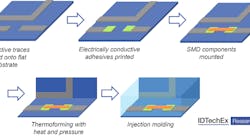With the integration of capacitive touch, lighting, and even haptics alongside size and weight reductions of up to 70%, in-mold electronics is an efficient approach to making curved touch-sensitive interfaces. Given these benefits, IDTechEx forecasts IME to be a $1.5 billion market by 2032, with applications mainly within the automotive and consumer goods sectors.
Greater integration of electronics within 3D structures is an ever-increasing trend, representing a more sophisticated solution compared to the current approach of encasing rigid printed circuit boards. In-mold electronics (IME) facilitates this trend, by enabling multiple integrated functionalities to be incorporated into components with thermoformed 3D surfaces.
A new manufacturing approach
IME can be regarded as an extension of the well-established in-mold decorating (IMD) process, in which thermoforming plastic with a decorative coating is converted to a 3D component via injection molding. Since IME is an evolution of an existing technique, much of the existing process knowledge and capital equipment can be reused.
Making an IME part begins with screen printing of conductive thermoformable inks, followed by deposition of electrically conductive adhesives and the mounting of electronics components such as LEDs. More complex multilayer circuits can also be produced by printing dielectric inks to enable crossovers. The figure below shows a schematic of the IME manufacturing process flow.
Challenges and innovation opportunities
The integration of electronic functionality brings multiple technical challenges, primarily the need for circuitry and components to withstand thermoforming and injection molding to enable the high manufacturing yield required. The comprehensively updated IDTechEx report, “In-Mold Electronics 2022-2032: Technology, Market Forecasts, Players”, covers the commercial and emerging solutions from the key players from design, materials, and manufacturing as IME progresses from R&D to gaining widespread adoption in multiple application sectors.
On the material side, conductive inks, dielectric inks, and electrically conductive adhesives need to survive the forming and molding steps that involve elevated temperatures, pressure, and elongation. Furthermore, all the materials in the stack will need to be compatible. As such, many suppliers have established functional material portfolios for IME to position themselves for future growth.
The IDTechEx report examines the current situation in terms of material performance, supply chain, process know-how, and application development progress. It also identifies the key bottlenecks and innovation opportunities, as well as emerging technologies associated with IME such as thermoformable particle-free inks.
Commercial progress
IME is most applicable to use cases that require a decorative touch-sensitive surface, such as control panels in automotive interiors and on kitchen appliances. It enables a 3D, smooth, wipeable, decorative surface with integrated capacitive touch, lighting and even haptic feedback and antennas. While the first commercial examples are beginning to emerge in the consumer goods space, adoption in commercially available vehicle interiors has been delayed due to COVID-19.
Despite this setback, the market is beginning to change character towards product production, with equipment suppliers developing specialist capabilities and development projects reaching their conclusion. IDTechEx expects the market to show accelerated growth from 2024/2025 onwards, starting from simpler small-area devices then progressing towards more complex larger-area and higher-volume applications with more stringent reliability requirements.
The long-term target for IME is to become an established platform technology, much the same as rigid PCBs are today. Once this is achieved getting a component/circuit produced will be a simple matter of sending an electronic design file, rather than the time-consuming process of consulting with IME specialists that is required at present.

